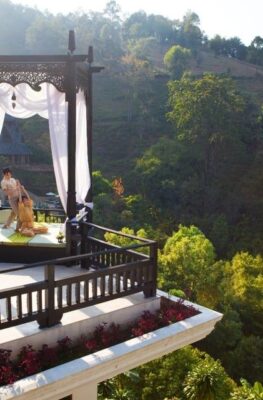Published on November 29, 2017

Hanoi Opera House. Image courtesy of Viet Nam National Administration of Tourism.
What You’ll Get
Take this 11-day/10-night program to see Laos and Viet Nam’s top spots: a study in contrasts that works well together nonetheless!
Highlights
Tap into the sacred when you visit Laos and Viet Nam’s top temple highlights; take in both countries’ traditional crafts, historical remnants, and shopping streets. Both countries may seem different on the surface, but when put together in a single itinerary, Laos and Viet Nam offer a unified front for fun.
The iconic That Luang Stupa in Vientiane, Laos introduces you to a series of compelling structures, including Wat Sisaket which contains remarkable frescoes and 6,840 Buddha statues; Ho Prakeo, site of some of Laos’ finest Buddhist artifacts; and the imposing Patuxay Monument, well known as Vientiane’s own Arc de Triomphe.
Luang Prabang was Laos’ former royal capital, and its temples and other sights reflect its high status in history. 32 temples in the vicinity, including the magnificent Wat Xiengthong; the Royal Palace, converted into Laos’ National Museum; and nearby Mount Phousi, where you can get a bird’s eye view of the city and a dazzling sight of sunset over Luang Prabang.
The scenic road to Xiengkhuang passes by hill tribe villages before reaching the site of the Plain of Jars, an impressive archaeological site where hundreds of large stone jars are scattered all over the plateau.
A further drive across the Laos-Viet Nam border takes you to Vinh, where President Ho Chi Minh’s birthplace, Kim Lien Village, stands today – here, century-old farm houses made of bamboo and palm leaves are still being restored.
Hanoi‘s thousand-year-old streets still recall empires and leaders of the past, from the scenic Hoan Kiem Lake to the Temple of Literature to expansive Ba Dinh Square, around which you’ll find the Presidential Palace, the One Pillar Pagoda, and Ho Chi Minh’s Mausoleum. Ha Long Bay, the famously scenic body of water, is just a few hours’ drive from the city.
Finally, Ho Chi Minh City – still known to locals as “Saigon” – offers a balance between history and nature. Start by exploring Cu Chi Tunnels, hand-dug by the winning side during the Viet Nam War; and continue through central Saigon’s colonial-era landmarks, among them the Reunification Palace, the Central Post Office, and Dong Khoi Street. Later, you’ll visit a Mekong Delta village to experience life as the locals do.
For a complete listing of destinations and experiences in this itinerary, visit this page on SaigonTourist’s official site.

That Luang Temple, Vientiane. Image courtesy of Tourism Laos.






